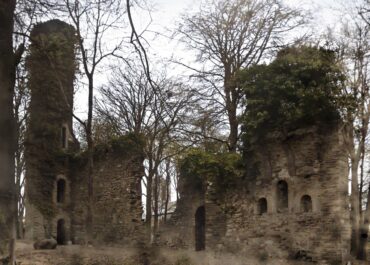Round Tower at St. Patrick's Rock, Cashel
Ireland's most architecturally connected round tower rises from Cashel's sacred rock with a secret passage linking it to the Gothic cathedral; where medieval engineers created the only round tower in the country that you can enter without ever stepping outside.
Round Tower at St. Patrick's Rock, Cashel
Standing on the south side of the summit of the famous Rock of Cashel, this magnificent round tower represents one of Ireland’s most architecturally sophisticated and historically significant examples. Rising 27.9 meters (including its 4.42-meter conical cap) and uniquely connected to the adjacent 13th-century cathedral through a passage, the tower combines exceptional preservation with remarkable integration into one of Ireland’s most important ecclesiastical complexes.
Strategic Location and Commanding Position
The tower’s position “on the S side of the summit of a prominent rock outcrop overlooking the town of Cashel c. 300m to the S-SE” places it at one of Ireland’s most symbolically and strategically important ecclesiastical sites. The Rock of Cashel served as both a royal stronghold and ecclesiastical center, making the round tower part of a complex that represented both temporal and spiritual authority.
The tower’s location within this broader archaeological landscape, which includes “a Romanesque chapel c. 30m to the S and a high cross c. 50m to the SW,” demonstrates careful medieval planning that created a coordinated ensemble of ecclesiastical monuments on the rock’s summit.
Architectural Integration with Cathedral
The tower’s most remarkable feature is its physical connection to the 13th-century Gothic cathedral through a passage system. Positioned “at the NE corner of the N transept of the 13th-century cathedral to which it was connected by a passage,” the tower represents a unique example of medieval architectural integration that transformed an independent round tower into part of a larger ecclesiastical complex.
“A second doorway situated in the W face of the tower gives access to the connecting triforium passage of the cathedral,” creating an internal circulation system that allowed movement between the ancient tower and the medieval cathedral. This integration demonstrates sophisticated architectural planning that respected the tower’s historical significance while adapting it for new liturgical functions.
Construction Quality and 12th-Century Dating
The tower “was most likely erected in the 12th century following the transfer of St. Patrick’s Rock to the church,” placing its construction during the period of major ecclesiastical development at Cashel. Built from “coursed sandstone with limestone in evidence in the lower masonry courses,” the structure demonstrates high-quality medieval craftsmanship using carefully selected materials.
The substantial dimensions—5.33 meters diameter and nearly 28 meters height—indicate this was built for one of Ireland’s most important ecclesiastical centers, with resources sufficient to fund construction on this impressive scale.
Sophisticated Doorway Orientation
The “original round-headed doorway (H 1.65m; Wth 0.74m; H above ground 3.28m) faces SE, probably towards the W doorway of the first cathedral which was built by c. 1111.” This strategic orientation demonstrates deliberate architectural coordination between the round tower and the earlier Romanesque cathedral, creating visual and functional relationships between the structures.
This alignment suggests the tower was designed to complement the cathedral complex rather than stand in isolation, emphasizing the integrated nature of the medieval ecclesiastical planning at Cashel.
Window Arrangement and Bell Chamber
The tower’s fenestration follows a sophisticated system: “three flat-headed single-lights at various intervals facing N, NE and SE” provide lighting to the main floors, while “the top floor, which housed the bell or bells, has four triangular-headed single-light windows, just below the cornice, facing NE, SE, NW and SW respectively.”
This arrangement ensured optimal sound transmission from the bell chamber while providing controlled lighting throughout the structure. The triangular-headed windows at the top represent sophisticated medieval stonework that created both functional and aesthetic elements.
19th-Century Conservation
The tower underwent major restoration by the Office of Public Works in 1874-75, when “most of the masonry was repointed and the conical cap reset.” This early conservation work preserved the tower’s medieval profile and structural integrity, representing one of the pioneering systematic approaches to Irish monument conservation.
The restoration ensures that visitors today can appreciate the tower’s complete medieval form, including the impressive conical cap that crowns the structure and provides weather protection for the interior.
Archaeological Excavation of 1841
The tower’s interior was excavated in 1841, revealing important evidence about its construction and use history. The excavation found the interior “filled with loose earth, intermixed with human bones, about two feet [c. 0.6m] deep; under this was a mass of solid stone-work, forming the original floor of the building, about five feet nine [c. 1.7m] below the door.”
Most significantly, when “workmen penetrated to the rock on which the tower was built; small fragments of charcoal were found at the base of the tower.” This charcoal may represent evidence of ritual activities, construction practices, or possibly fire damage, providing rare archaeological evidence about round tower foundations and early use.
Evidence of Human Remains
The presence of human bones mixed with earth in the tower’s interior suggests either burial activities within the tower or the disturbance of earlier burials during construction. This evidence indicates the tower site had complex use history and may have been built over an earlier cemetery area, following patterns documented at other major Irish ecclesiastical sites.
Architectural and Historical Significance
The Cashel round tower represents the pinnacle of Irish round tower architecture and integration, combining exceptional medieval craftsmanship with unique architectural relationships to later buildings. The passage connection to the Gothic cathedral is unparalleled among Irish round towers and demonstrates innovative medieval approaches to incorporating ancient monuments into evolving ecclesiastical complexes.
Good to Know
Location: Rock of Cashel, County Tipperary South (summit of rock outcrop)
Dimensions: 5.33m diameter, 27.9m total height (including 4.42m conical cap)
Dating: 12th century (following transfer of Rock to church)
Unique features: Connected to cathedral by passage, second doorway to triforium
Materials: Coursed sandstone with limestone in lower courses
Conservation: OPW restoration 1874-75 (repointing and cap reset)
Archaeological evidence: 1841 excavation revealed human bones, charcoal at base, original stone floor
Architectural significance: Unique integration with Gothic cathedral through passage system
Tags
Visitor Notes
Added by
Pete
Lennox Barrow, G. 1979 The round towers of Ireland: a study and gazetteer. Dublin. The Academy Press.
O’Keeffe, T. 2003 Romanesque Ireland. Architecture and ideology in the twelfth century. Dublin. Four Courts Press.
Stalley, R. 1996 The Rock of Cashel (Tipperary). Archaeological Journal 153, 308-14.
Coleman, J. 1914 South Munster antiquarian researches at Ardmore and Cashel. Journal of the Cork Historical and Archaeological Society 20, 100-02.


